Agile methodologies like Scrum have revolutionized the way teams approach product development. Central to the Agile framework is the concept of the Sprint Backlog, a tool for managing tasks and priorities within a sprint cycle. In this guide, we explore a way of building an effective Sprint Backlog, offering insights and best practices for Agile teams to optimize their workflow.
Understanding the Basics: Key Concepts Before Building Backlogs
Before building backlogs, it's crucial to grasp fundamental product development concepts, like: Scrum and Agile Frameworks, User Stories, Acceptance Criteria, Effort Estimation, and Epics.
Scrum and Agile Frameworks
Scrum is an Agile framework used for managing complex software development projects. It provides a structured approach to product development, emphasizing iterative and incremental delivery, adaptability to change, and collaboration within cross-functional teams. In Scrum, work is organized into short iterations called "sprints," typically lasting two to four weeks. At the beginning of each sprint, the team conducts a planning meeting to select items from the product backlog, a prioritized list of features and tasks, to work on during the sprint. The team commits to completing these selected items by the end of the sprint.
Besides Scrum, there are several other Agile frameworks commonly used in software development, such as Kanban, Extreme Programming (XP), Lean, and Crystal. Each of these frameworks has its own unique principles, practices, and methodologies, but they all share the common goal of delivering value to customers through iterative and incremental development. Overall, regardless of the specific Agile framework used, backlogs play a central role in enabling teams to manage and prioritize their work effectively, ensuring that they deliver value to stakeholders in a timely and transparent manner.
User Stories
User stories are concise, simple descriptions of a feature or functionality from the perspective of an end-user. They are a fundamental component of Agile development methodologies, particularly in Scrum. A user story typically follows a straightforward template:
As a [role], I want [feature/functionality], so that [benefit]
Here's a breakdown of the components:
- Role: This identifies the user or stakeholder who will benefit from the feature.
- Feature/Functionality: This describes what the user wants to accomplish or the specific functionality they desire.
- Benefit: This explains the reason behind the feature or how it will add value to the user or the project.
User stories are intentionally brief and focused on the user's perspective. They help teams understand the user's needs, goals, and motivations, guiding the development process to deliver solutions that address real user requirements. By articulating user stories, teams can prioritize tasks effectively, focus on delivering value to users, and ensure that the end product meets customer expectations. User stories also serve as a basis for communication and collaboration between stakeholders, product owners, and development teams throughout the project lifecycle. It's important to adhere to the INVEST criteria to ensure the stories are well-formed and effective. INVEST is an acronym that stands for:
- Independent: User stories should be independent of each other, meaning they can be implemented and delivered separately without dependencies on other stories.
- Negotiable: User stories should be open to discussion and negotiation between the development team and stakeholders. This allows for flexibility and refinement based on feedback and changing requirements.
- Valuable: User stories should deliver value to the user or customer. They should focus on meeting the needs and requirements of the end-user to provide tangible benefits.
- Estimable: User stories should be clear and well-defined enough for the development team to estimate the effort required for implementation. This helps with planning and prioritization.
- Small: User stories should be small enough to be completed within a single iteration or sprint. Breaking down larger features into smaller, manageable user stories allows for incremental delivery and feedback.
- Testable: User stories should be testable, meaning there should be clear criteria for determining when the story is complete and meets the acceptance criteria. This ensures that the team can validate that the implemented feature functions as intended.
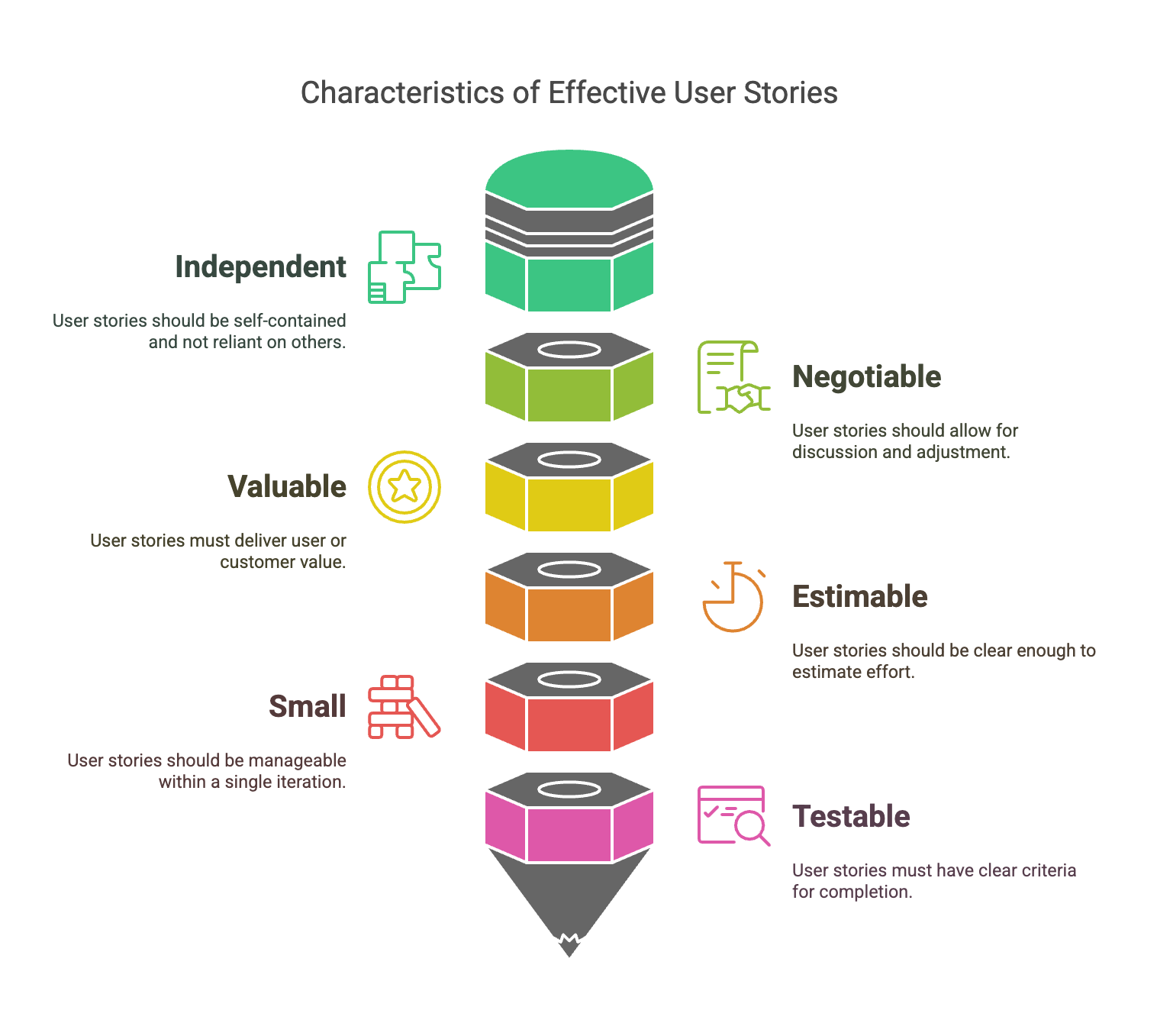
Acceptance Criteria
Acceptance criteria are specific conditions or requirements that a product or feature must meet to be accepted or approved by stakeholders and considered complete. They serve as the definition of done for a user story or a piece of functionality. Acceptance criteria outline the boundaries and expectations for the development team, providing clarity on what needs to be achieved to satisfy the user story. They are typically defined collaboratively by the product owner, stakeholders, and development team during the sprint planning or refinement sessions. Acceptance criteria should be:
- Clear: Clearly stated and unambiguous, leaving no room for interpretation.
- Measurable: Verifiable and quantifiable, allowing for objective assessment of whether the criteria have been met.
- Specific: Addressing the key requirements or functionalities that need to be implemented.
- Testable: Able to be validated through testing or demonstration to ensure they have been successfully implemented.
- Aligned with User Needs: Reflective of the user's needs, ensuring that the implemented feature provides value and addresses user requirements.
- Complete: Covering all aspects necessary for the feature to be considered complete and ready for delivery.
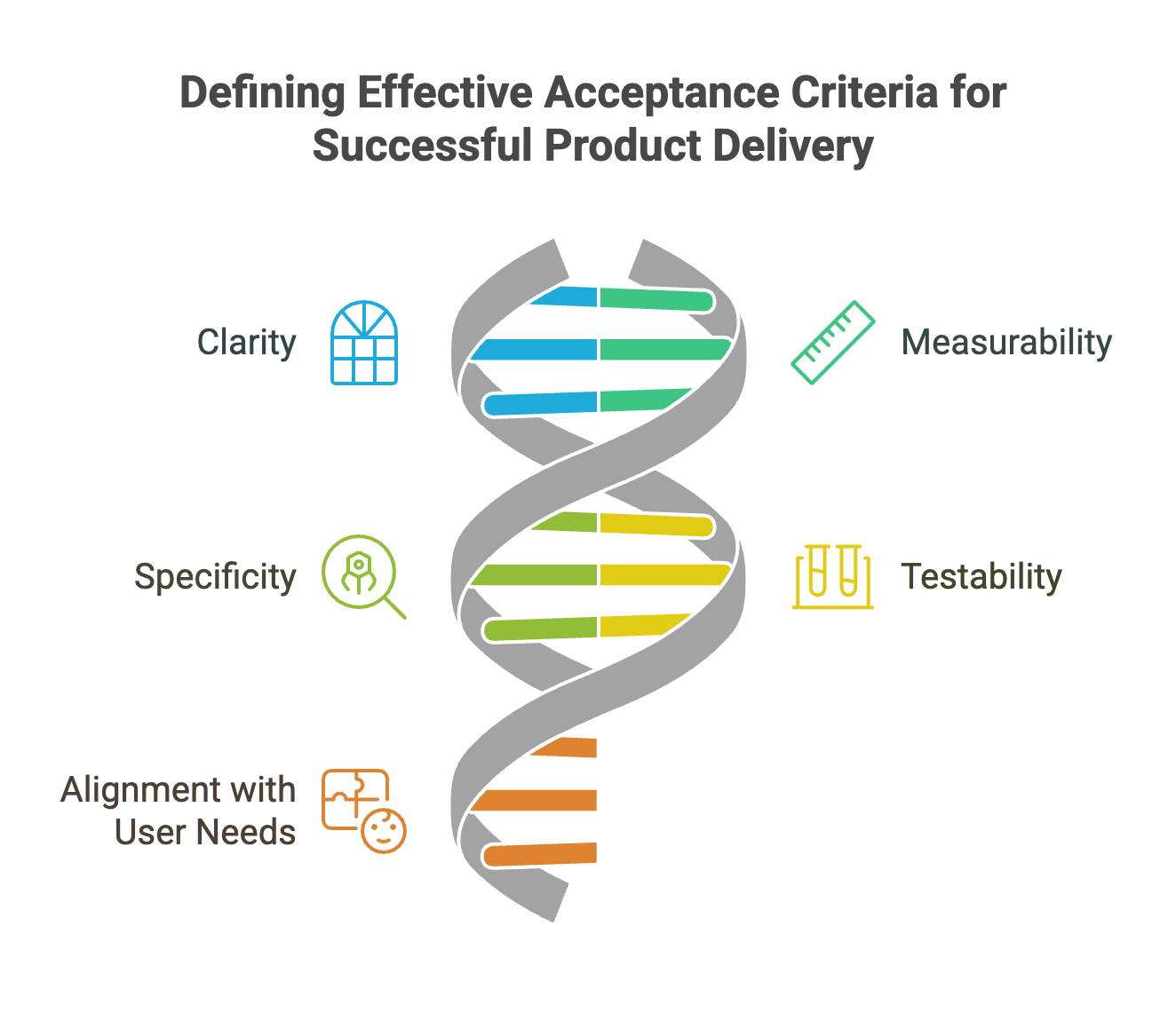
Acceptance criteria help ensure that the development team and stakeholders have a shared understanding of what constitutes a successful outcome for a user story. They provide a framework for assessing progress, guiding development efforts, and validating that the delivered product meets user expectations and business objectives.
Approaches to Effort Estimation
Effort estimation is a fundamental aspect of Agile project management, as it enables teams to effectively allocate resources and plan sprints. By estimating the effort required for each user story, teams can prioritize tasks based on their complexity and ensure that they have the necessary resources to complete them within the given time frame. Agile teams utilize a variety of approaches for effort estimation, each with its own strengths and considerations.
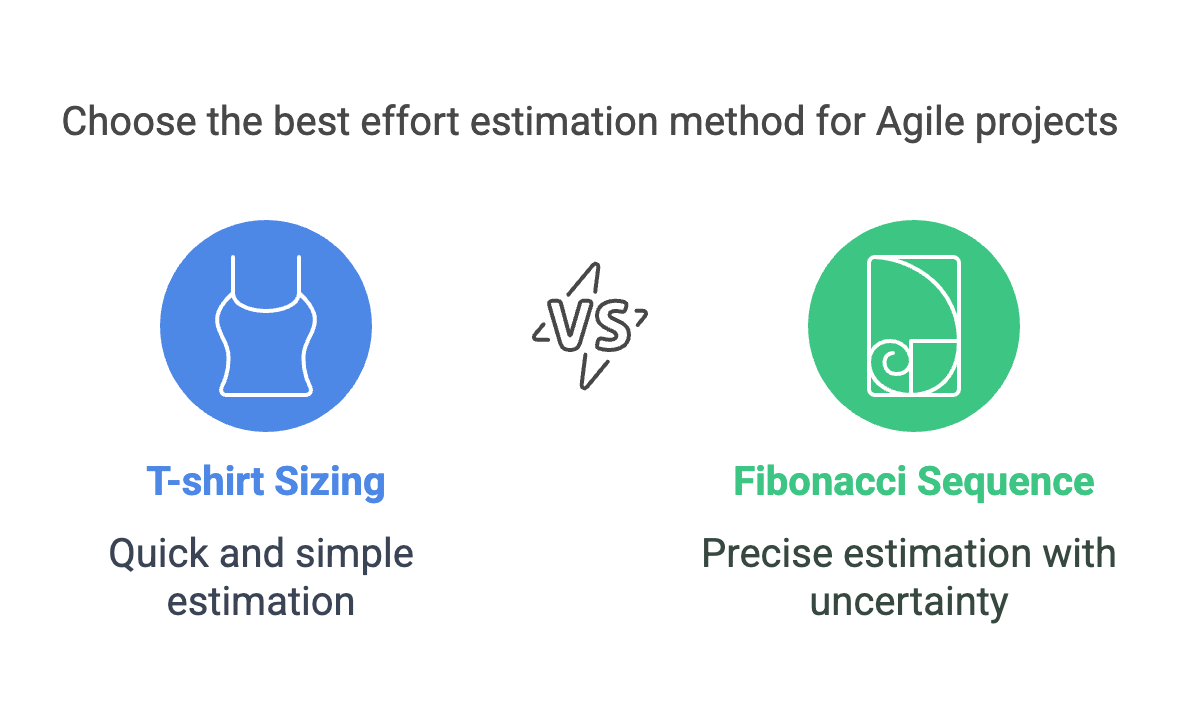
One commonly used approach is the T-shirt sizing method, where user stories are categorized into sizes such as small, medium, large, or extra-large based on their perceived complexity or effort required. This approach provides a quick and simple way to estimate relative sizes of user stories without getting bogged down in detailed analysis. However, it may lack precision and granularity, making it less suitable for projects with highly varied or intricate requirements.
Another popular method is the Fibonacci sequence, where each user story is assigned a numerical value from the Fibonacci series (e.g., 1, 2, 3, 5, 8, 13, etc.) based on its complexity. This approach allows for more precise estimation while still accommodating the inherent uncertainty in software development. The Fibonacci sequence acknowledges that as the size or complexity of a task increases, the level of uncertainty also grows, making it a practical approach for Agile teams to manage uncertainty and variability in their estimations.
In addition to these estimation techniques, Agile teams also rely on velocity as a key metric for forecasting project timelines and iterations. Velocity measures the team's capacity to deliver work within a sprint based on their historical performance. By tracking the number of user story points completed in each sprint, teams can calculate their average velocity and use it as a guide for planning future sprints. Velocity provides valuable insights into the team's productivity and helps stakeholders make informed decisions about project scope and timelines. Overall, by employing various estimation approaches and leveraging velocity as a predictive tool, Agile teams can enhance their ability to plan and execute projects efficiently while adapting to changing requirements and priorities.
Epics in the Context of Backlog Creation
In scenarios where user stories are too large to be completed within a single sprint, they are grouped into epics. Epics serve as overarching themes that encompass multiple user stories, allowing teams to break down complex initiatives into manageable tasks. When a user story is too large to be completed within a single sprint or iteration, it is often categorized as an epic. Epics serve as high-level placeholders or containers that encapsulate multiple related user stories, representing overarching themes or objectives that contribute to the project's goals.
Product Backlog
Defining the Product Backlog
The product backlog is a dynamic and prioritized list of all the features, enhancements, bug fixes, and other work items that need to be addressed in a product. It serves as the single source of requirements for any changes to the product. This list is continuously refined and updated throughout the project lifecycle based on feedback, changing priorities, and new requirements. Items in the backlog are typically expressed as user stories, which describe the desired functionality from the perspective of an end-user. However, the backlog can also include technical tasks, research activities, and any other work necessary to deliver value to the customer.
Who Manages the Product Backlog?
In Agile methodologies like Scrum, the Product Owner is the primary individual responsible for managing the product backlog. This role involves collaborating closely with stakeholders, including customers, users, and the development team, to prioritize features and refine user stories. The Product Owner acts as the bridge between the business and development sides of the project, ensuring that the backlog reflects the needs and priorities of all stakeholders. Through ongoing communication and feedback loops, the Product Owner continuously grooms the backlog, updating priorities, clarifying requirements, and removing outdated or irrelevant items. This active management of the backlog ensures that it remains aligned with evolving project goals and market demands, maximizing the value delivered by the development team.
Essential Tasks for Product Backlog Maintenance
Essential tasks for product backlog maintenance involve continuous refinement and prioritization to ensure that the backlog remains up-to-date and aligned with project goals. Product Owners work closely with the development team to elaborate on user stories, providing more details, clarifications, and context as needed. This collaborative effort helps to ensure that user stories are well-defined, actionable, and accurately represent the needs of stakeholders and users.
Additionally, during this phase, acceptance criteria are established or improved upon to provide precise rules for the determination of when a user story is finished. Furthermore, efficient backlog maintenance depends on modifying priorities in response to shifting market conditions and demand.
As new information emerges or stakeholder priorities shift, Product Owners must reassess and reprioritize backlog items accordingly. This iterative process allows teams to remain responsive to evolving needs and ensures that the most valuable and impactful features are addressed first. By optimizing the product backlog through ongoing refinement and prioritization, teams can enhance efficiency, focus on delivering value, and ultimately drive the success of the project.
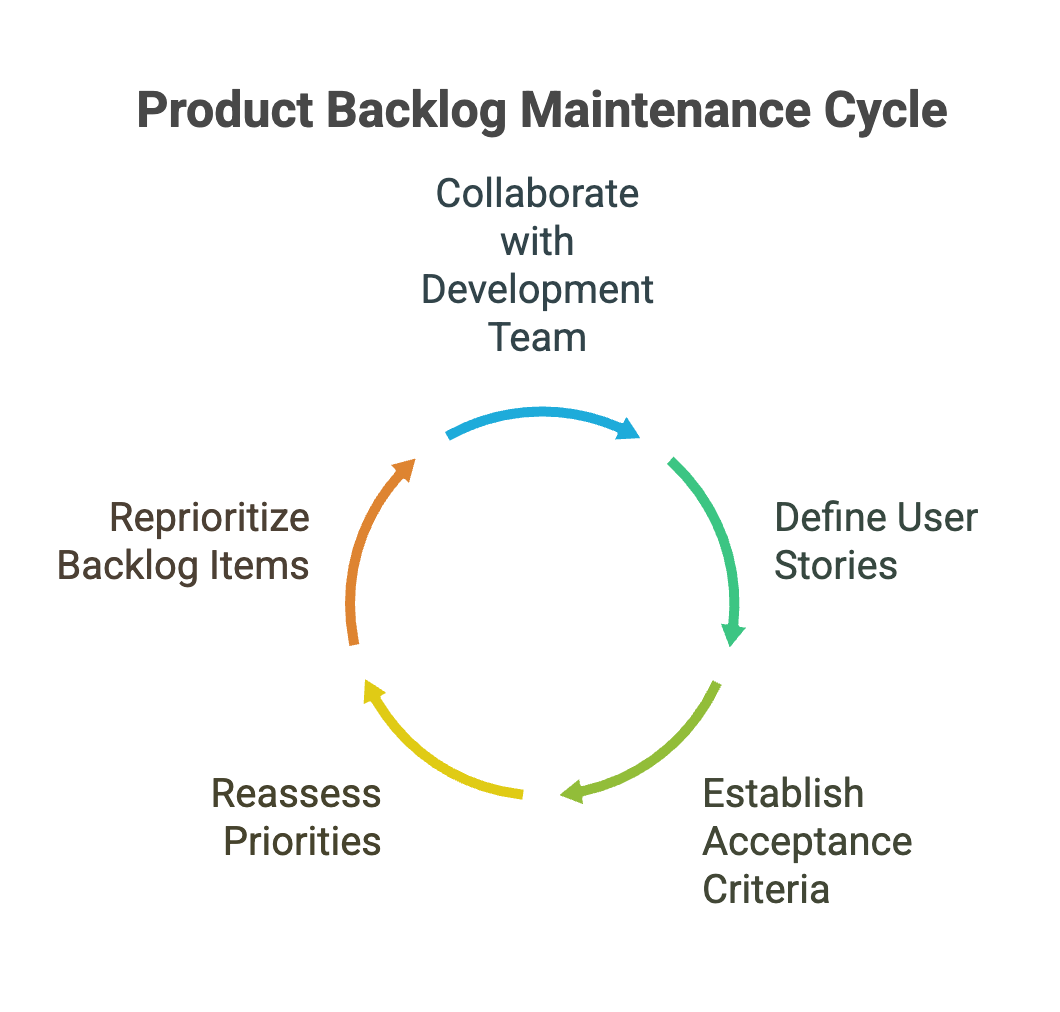
Determining When to Utilize the Product Backlog
Determining when to utilize the product backlog is essential for ensuring that it serves as a valuable tool throughout the product lifecycle. Initially, the product backlog comes into play during the project initiation phase, where stakeholders collaborate to define the product vision, goals, and high-level requirements. As the project progresses, the product backlog continues to inform project planning and execution by guiding sprint planning sessions and providing a roadmap for development activities.
During sprint planning, the development team selects backlog items to work on based on their priority and estimated effort, ensuring that the most valuable features are addressed first. Moreover, the product backlog remains relevant and useful beyond the initial planning stages, serving as a dynamic document that adapts to changing circumstances and requirements. Throughout the product lifecycle, teams continually groom the backlog, updating priorities, refining user stories, and incorporating new insights and feedback.
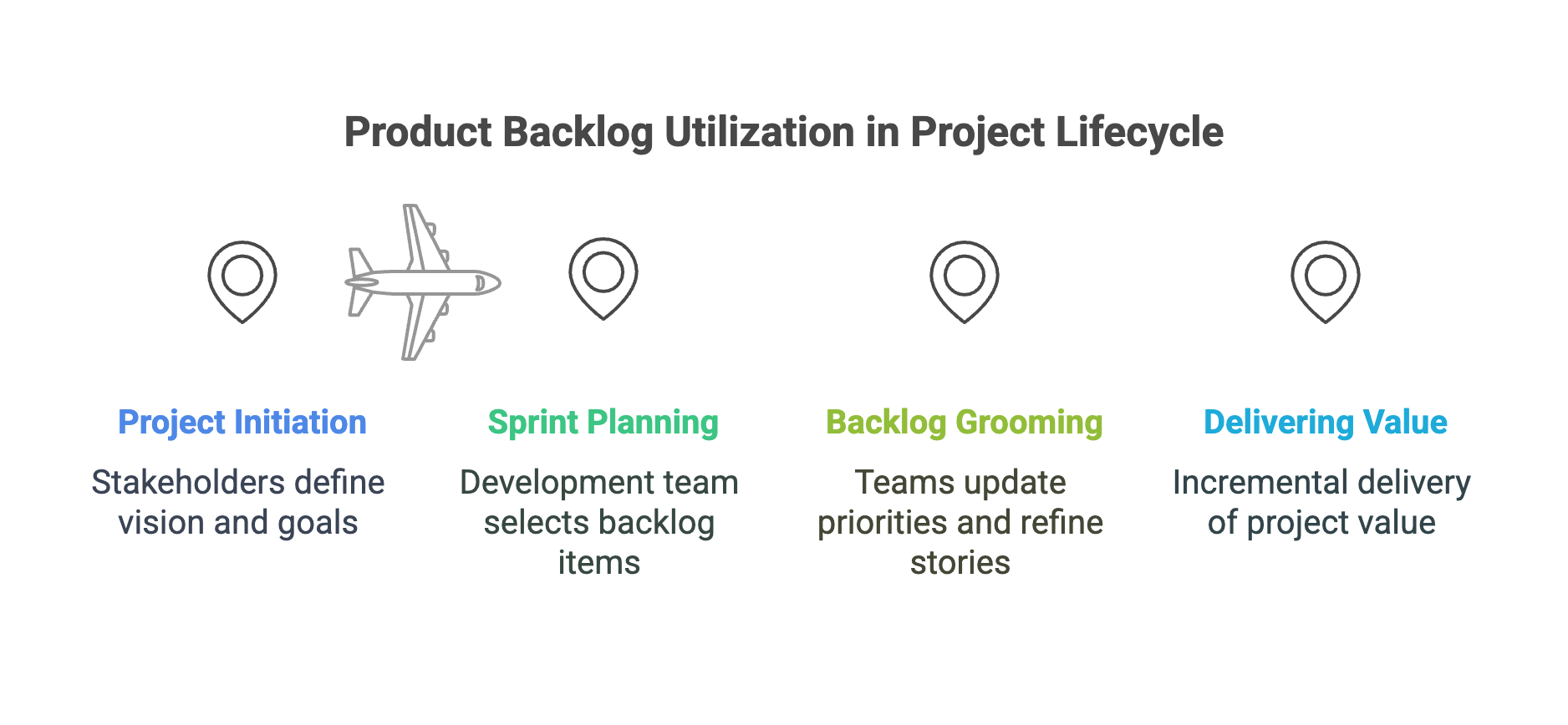
By leveraging the product backlog as a flexible and adaptive tool, teams can effectively manage evolving project needs and deliver value incrementally and iteratively. This iterative approach allows for agility and responsiveness in addressing emerging challenges and opportunities, ultimately enhancing the likelihood of project success.
Sprint Backlog
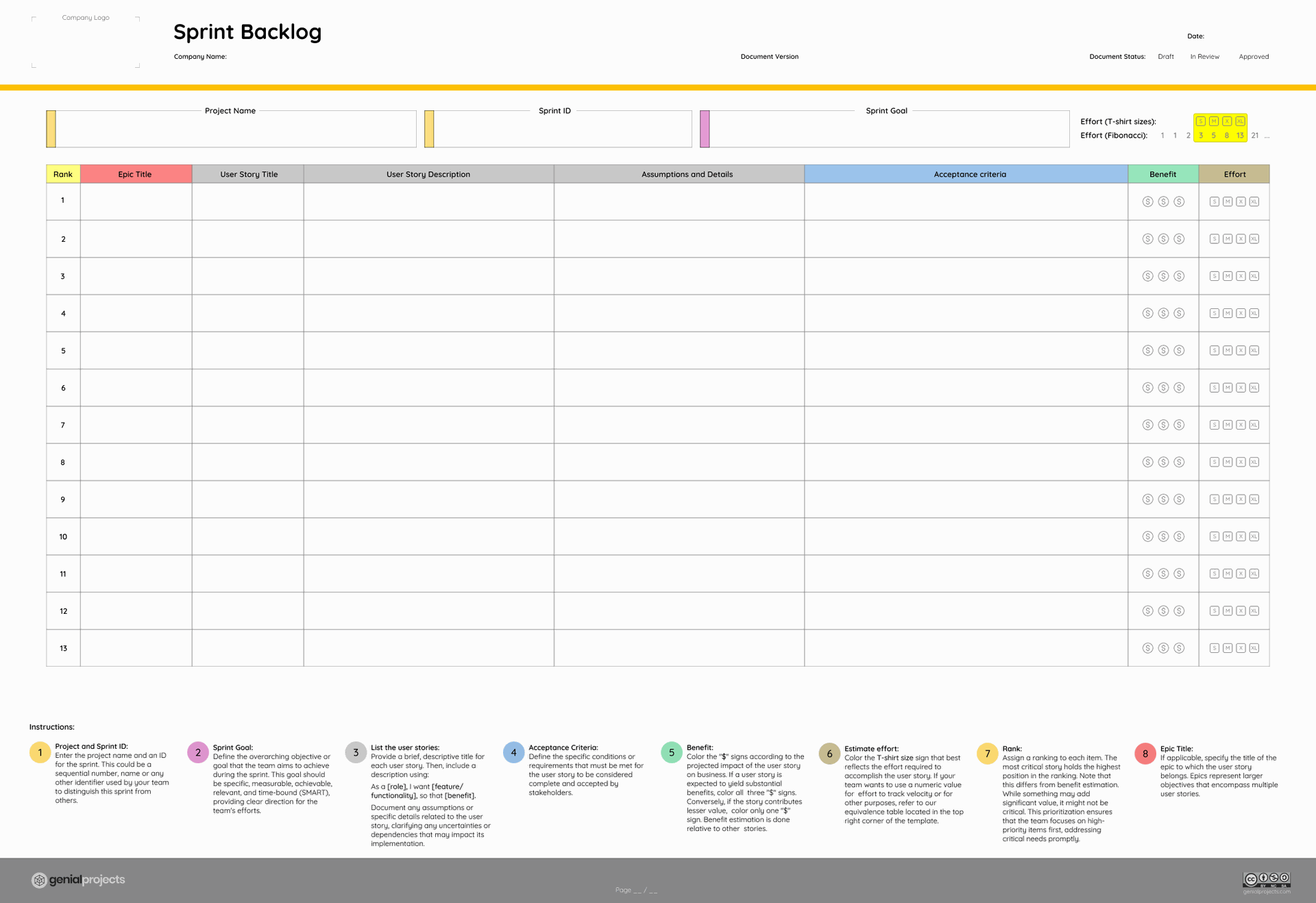
Defining the Sprint Backlog
The sprint backlog is the blueprint for the work to be accomplished within a specific sprint cycle. During sprint planning, the development team collaborates to select a subset of user stories from the product backlog that can be realistically completed within the sprint's timeframe. These user stories are chosen based on their priority, value, and feasibility, ensuring that the team focuses on delivering the most impactful features first. Additionally, the sprint backlog may also include technical tasks, bug fixes, or other items necessary to achieve the sprint goal and move the project forward.
Furthermore, the sprint backlog provides a clear and tangible plan of action for the development team, outlining the specific tasks and activities that need to be completed during the sprint. By breaking down user stories into smaller, actionable tasks, the sprint backlog helps the team maintain focus and momentum, enabling them to make steady progress towards achieving the sprint goal. This transparency and clarity foster a sense of accountability and ownership within the team, driving collaboration and commitment to delivering high-quality work within the sprint timeframe.
Free Sprint Backlog Template available on our website.
Who Manages the Sprint Backlog?
In Agile development methodologies like Scrum, the Product Owner establishes the sprint goal based on the priorities outlined in the product backlog. However, it is the development team that assumes responsibility for managing the sprint backlog during the sprint cycle. This collaborative approach ensures that the team has ownership over the tasks they commit to completing within the sprint timeframe. The development team engages in detailed planning sessions to select user stories from the product backlog and break them down into actionable tasks for inclusion in the sprint backlog.
By taking ownership of the sprint backlog, the development team gains autonomy and accountability in deciding how to accomplish the sprint goal. The management of the sprint backlog involves ongoing collaboration and coordination among team members. During sprint planning meetings, team members collectively discuss and estimate the effort required for each task, ensuring that the workload is distributed effectively among team members. Throughout the sprint, the development team monitors progress, adjusts priorities as needed, and collaborates to overcome any obstacles or challenges that may arise. This collaborative and iterative approach to managing the sprint backlog fosters a sense of shared responsibility and empowers the development team to deliver value efficiently and effectively within the sprint timeframe.
Essential Tasks for Sprint Backlog Management
Essential tasks for sprint backlog management encompass a series of activities aimed at ensuring the successful execution of the sprint. One crucial aspect is refining user stories to ensure they are well-understood and actionable by the development team. This involves breaking down user stories into smaller, more manageable tasks, defining acceptance criteria, and clarifying any uncertainties or ambiguities. Additionally, task complexity estimation plays a vital role in sprint backlog management.
The development team collaboratively estimates the effort required for each task using relative estimation techniques such as planning poker or t-shirt sizing. This process helps teams allocate work effectively based on their capacity and ensures a balanced distribution of tasks among team members. Furthermore, maintaining a clear understanding of sprint goals is essential for effective sprint backlog management. Teams should continuously align their work with the sprint goal, focusing on delivering value that contributes to the overall project objectives. Regular communication and collaboration among team members are crucial for keeping everyone aligned and informed about the sprint's progress and priorities. By optimizing their workflow and ensuring alignment with sprint goals, teams can maximize productivity and deliver high-quality work within the sprint timeframe.
Understanding the Timing for Sprint Backlog Utilization
The sprint backlog is established during the sprint planning meeting, which typically occurs at the beginning of each sprint cycle. As mentioned earlier, during this meeting, the development team collaborates to select a subset of user stories from the product backlog and break them down into actionable tasks that can be realistically completed within the sprint's timeframe. This process involves discussions about task dependencies, technical considerations, and individual team member capacity.
By setting clear objectives and defining specific tasks during the sprint planning meeting, teams lay the groundwork for successful execution and iterative development throughout the sprint. Furthermore, the sprint backlog is actively utilized throughout the sprint cycle to guide the team's work and monitor progress towards the sprint goal. Team members refer to the sprint backlog regularly to understand their assigned tasks, track their progress, and ensure that they remain focused on delivering the agreed-upon scope within the sprint timeframe. Daily stand-up meetings provide opportunities for team members to discuss their progress, address any obstacles or challenges, and make adjustments to the sprint backlog as needed.
By utilizing the sprint backlog as a dynamic and responsive tool throughout the sprint, teams can maintain alignment with project goals, adapt to changing circumstances, and deliver value incrementally and iteratively.
Best Practices for Sustainability
- Developing Detailed Product Backlog Stories: It is essential to prioritize thorough refinement of the user stories that are likely to be part of the next two sprints, avoiding committing too much to distant work. By focusing on detailing the product backlog stories, teams can minimize waste and maximize focus on achievable goals within the sprint timeframe. The rest of the user stories will remain at a more general level of detail until it is timely to address them or more information is available for progressive elaboration.
- Prioritizing Product Backlog Items: Effective prioritization of product backlog items is crucial for resource allocation and maximizing business value. By ordering backlog items based on criticality and business value, teams ensure that efforts are directed towards the most impactful features first, leading to better outcomes and sustainable progress.
- Maintaining a Lean Product Backlog: Sustainability in product development requires regular review and refinement of the product backlog. Teams should actively assess whether backlog items align with project goals and user needs, archiving or deprioritizing items that no longer contribute to the project's success. This practice helps maintain a lean backlog, preventing unnecessary clutter and ensuring that resources are focused on high-priority tasks.
- Preparation for Sprint Planning: Efficient sprint planning is essential for sustainable project progress. Collaboration with technical leads to estimate effort and refine user stories before sprint planning meetings facilitates efficient decision-making and resource allocation. By adequately preparing for sprint planning, teams can streamline the process and ensure that sprints are well-defined and achievable.
- Balancing User Stories and Tasks: Achieving sustainability in project delivery requires a clear distinction between user stories and tasks. Each backlog item should represent a meaningful deliverable aligned with project objectives. By balancing user stories, which outline user requirements and features, with tasks, which detail the steps required for implementation, teams ensure that their efforts contribute directly to project success and long-term sustainability.
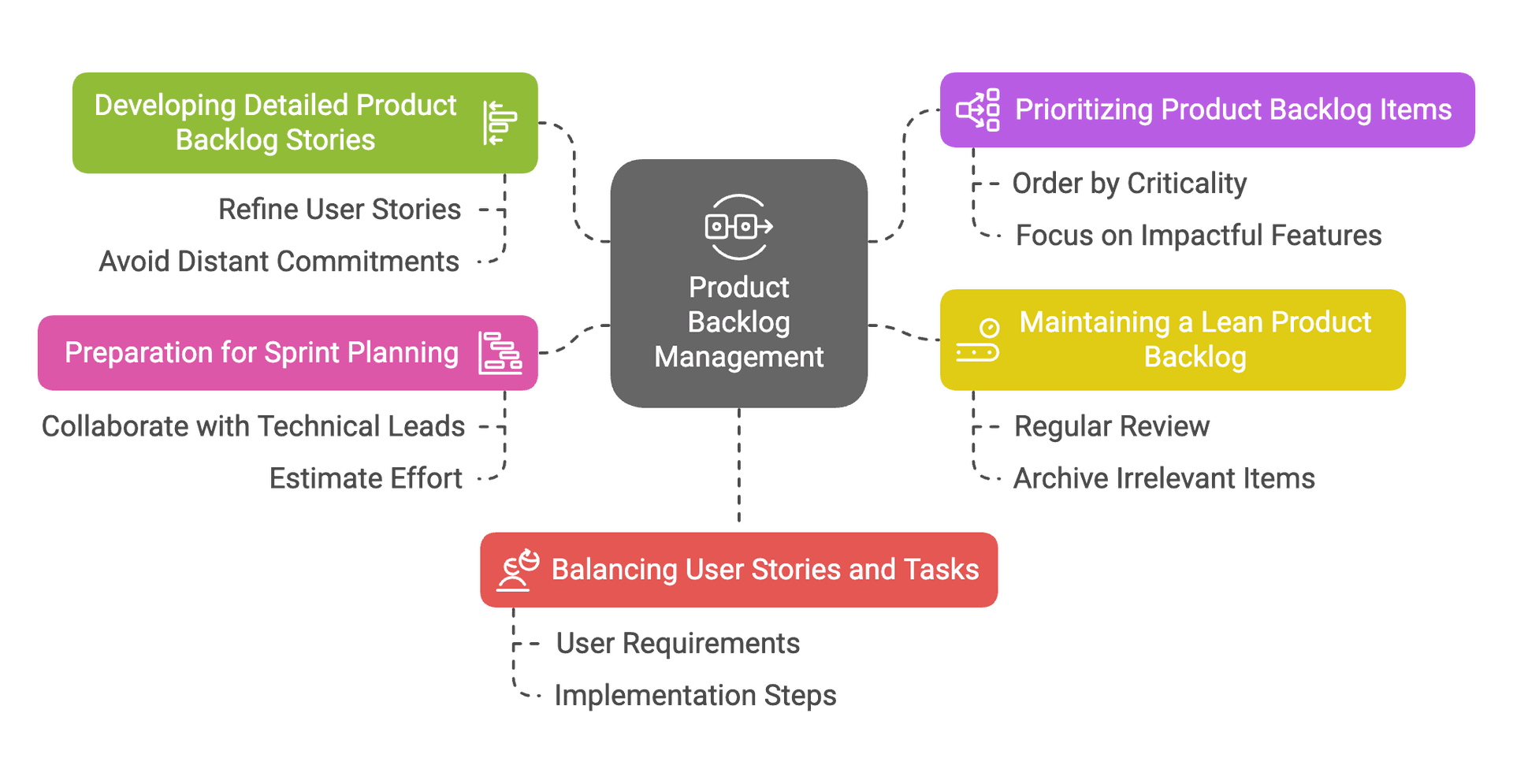
Key Takeaways
In conclusion, mastering the art of building and utilizing sprint backlogs is crucial for Agile teams aiming to thrive in today's dynamic business landscape. Agile methodologies emphasize adaptability and responsiveness, allowing teams to iterate rapidly and deliver value incrementally. By embracing these principles and honing their skills in refining user stories, teams can ensure that their development efforts remain closely aligned with evolving user needs and market demands.
Furthermore, effective management of both product and sprint backlogs enables teams to maintain a clear focus on delivering high-priority features while fostering a sustainable pace of work. This approach not only enhances the team's ability to meet customer expectations but also cultivates a culture of continuous improvement and innovation within the organization, ultimately driving long-term success and competitiveness in the market.